Using my favorite scones recipe, you can make bakery-style lavender scones right at home. Dried culinary lavender adds a lovely aromatic flavor without tasting overpowering. I love adding buttermilk and fresh lemon zest for extra flavor, too. The scones are crumbly, yet moist and perfect for spring brunches, tea parties, bridal showers, & Mother’s Day.
One reader, Cathy, commented: “I followed the recipe and these were a big hit. The flavors of the lavender and lemon came through and the scone was light and delicious! ★★★★★“
One reader, Nikia, commented: “I am about to make these for the 3rd time and am completely addicted! I LOVE all things lavender and I have just added these! The flavor is perfect! Not overwhelming and the glaze adds the perfect amount of sweetness! ★★★★★“

Let’s make Buttermilk Lavender Scones! But first, a briefing.
I never enjoyed floral flavors in baked goods—I mean, everything ends up tasting like hand soap or a candle. Am I alone here?!
Those were my thoughts until last year when, by the inspiration of Tessa who wrote Icing on the Cake, I tried Blackberry Lavender Cake. That day I ate my words and a fat piece of the most incredible cake to ever grace my tastebuds. Lavender, when used correctly, is DEEEEEELICIOUS.
Today I’m sharing a scone variation. Using my perfected scones recipe, I added fresh lemon zest and cooking lavender, swapped heavy cream for tangy buttermilk, and topped the scones with lemon lavender icing. These better-than-the-bakery scones are flaky and moist in the centers with crisp crumbly edges. The fresh spring flavors are completely divine and, thankfully, there’s not a trace of hand soapy flavor detected. 😉
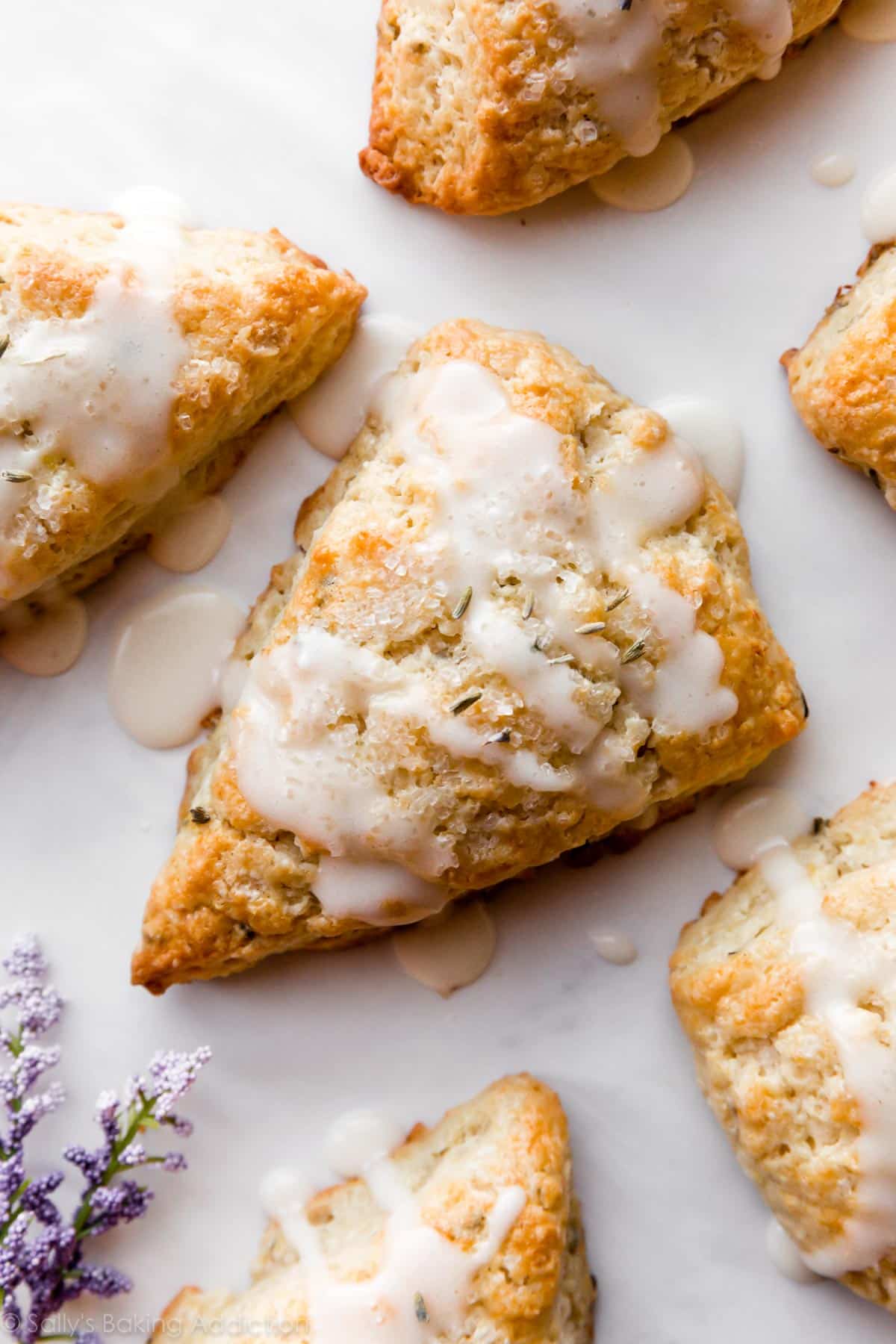
These Buttermilk Lavender Scones Are:
- Filled with bright lemon zest
- Lightly flavored with lavender
- Moist & soft inside
- Crumbly on the edges
- Buttery & flaky
- Not dry like most scones you’re used to
Use My Popular Scone Recipe
I have several scone recipes that begin with the same basic recipe. Have you ever tried my blueberry scones, apple cinnamon scones, or chocolate chip scones? Those are just a few reader favorites. You only need 10 ingredients for today’s lavender scones.
- Flour: 2 cups of all-purpose flour is my standard amount, but set extra aside for the work surface and your hands as you shape the scones.
- Sugar: Use 1/2 cup of sugar for this scone dough.
- Baking Powder: Adds lift.
- Salt: Adds flavor.
- Lemon Zest: Adds more flavor.
- Dried Culinary Lavender: Make sure you’re using the correct dried culinary lavender. (More on this crucial ingredient below.) You won’t bite into coarse pieces of dried lavender, though—they’re broken down when you cut the butter into the dough.
- Butter: Besides flour, butter is the main ingredient in scones. It’s responsible for flakiness, flavor, crisp edges, and rise.
- Buttermilk: For the best tasting scones, stick with a thick liquid such as heavy cream or buttermilk. I usually use heavy cream, but I craved a slightly tangy flavor with the lavender, so I reached for buttermilk. If you’re interested, I have more information on the science of baking with buttermilk here (including a DIY buttermilk substitute recipe).
- Egg: Adds flavor, lift, and structure.
- Vanilla Extract: Vanilla extract adds flavor.
Scones Video Tutorial
Here’s a 5 minute video demonstrating the process. I’m making blueberry scones in this video, but the process is the same. For these lavender scones, you’ll add lemon zest and lavender to the dry ingredients and swap heavy cream for buttermilk.
Frozen Grated Butter – The Secret in These Lavender Scones
Did you know that keeping scone dough as cold as possible prevents over-spreading? (Same thing with cookie dough!) When scones over-spread in the oven, they lose the flaky, moist, and deliciously crumbly texture. The easiest way to avoid disaster is to use cold ingredients like cold buttermilk, egg, and butter. Don’t waste your time and money by overlooking this!
However, frozen + grated butter is the secret to real scone success. Like we do when making pie crust, work the cold butter into the dry ingredients to create crumbs. The butter/flour crumbs melt as the lavender scones bake, releasing steam and creating air pockets. These pockets create a flaky center while keeping the edges crumbly and crisp. Refrigerated butter might melt in the dough as you work with it, but frozen butter will hold out until the oven. And the finer the pieces of cold butter, the less the scones spread and the quicker the butter mixes into the dry ingredients.
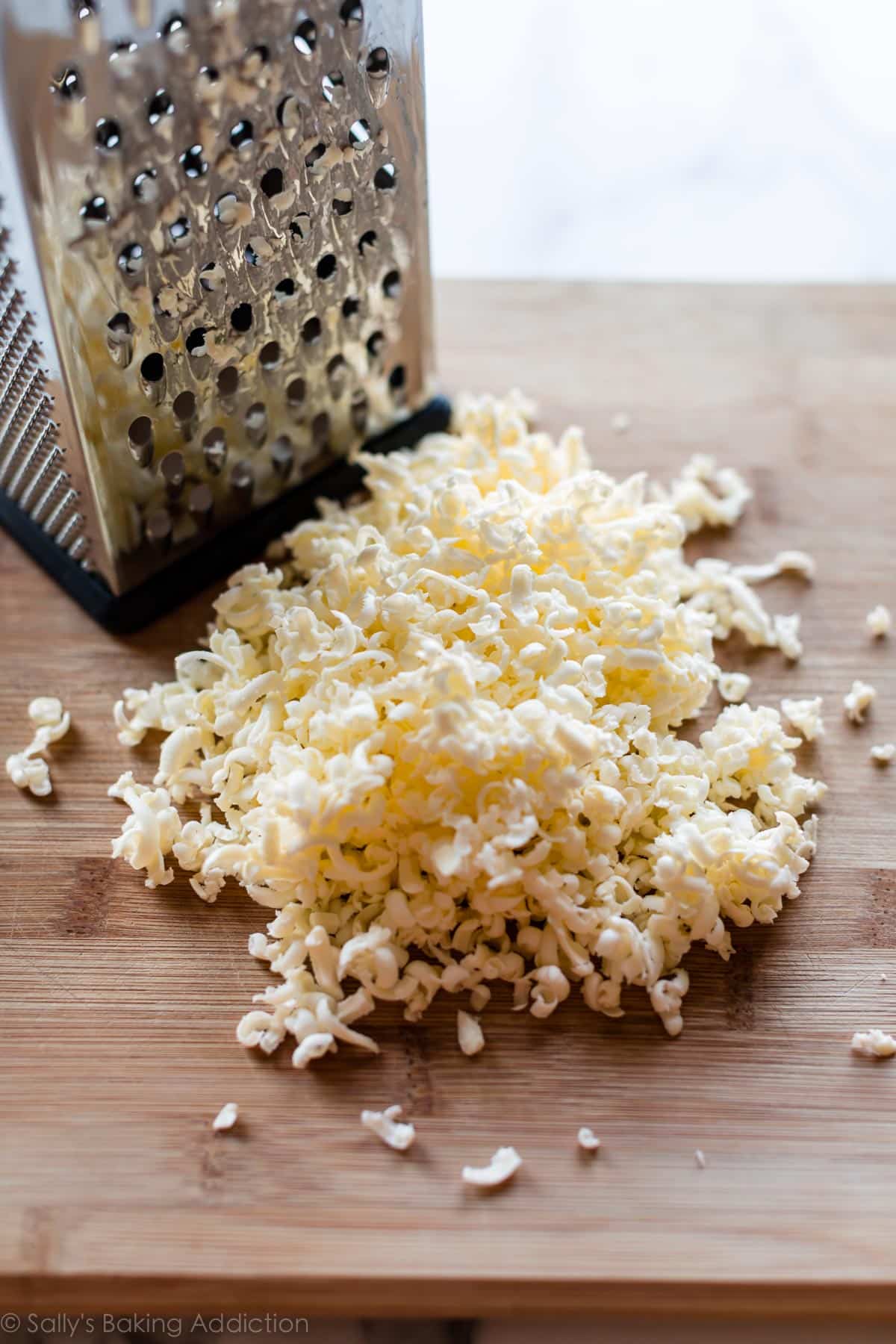
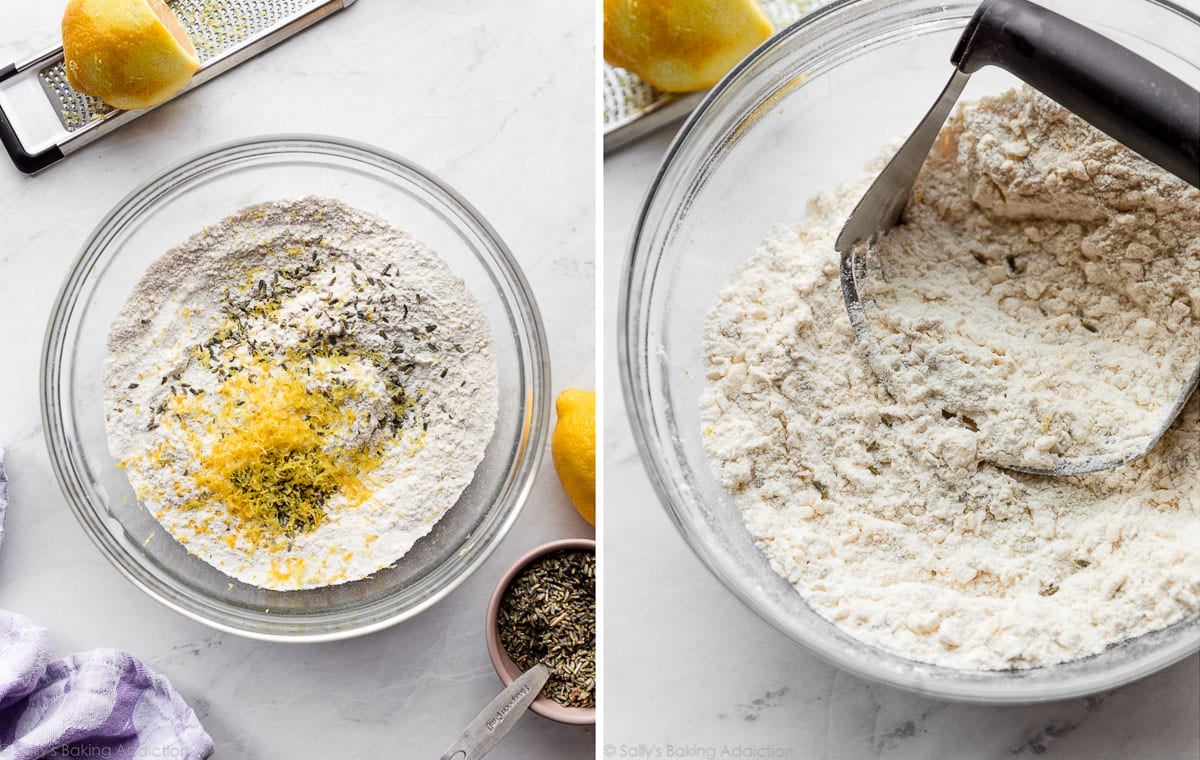
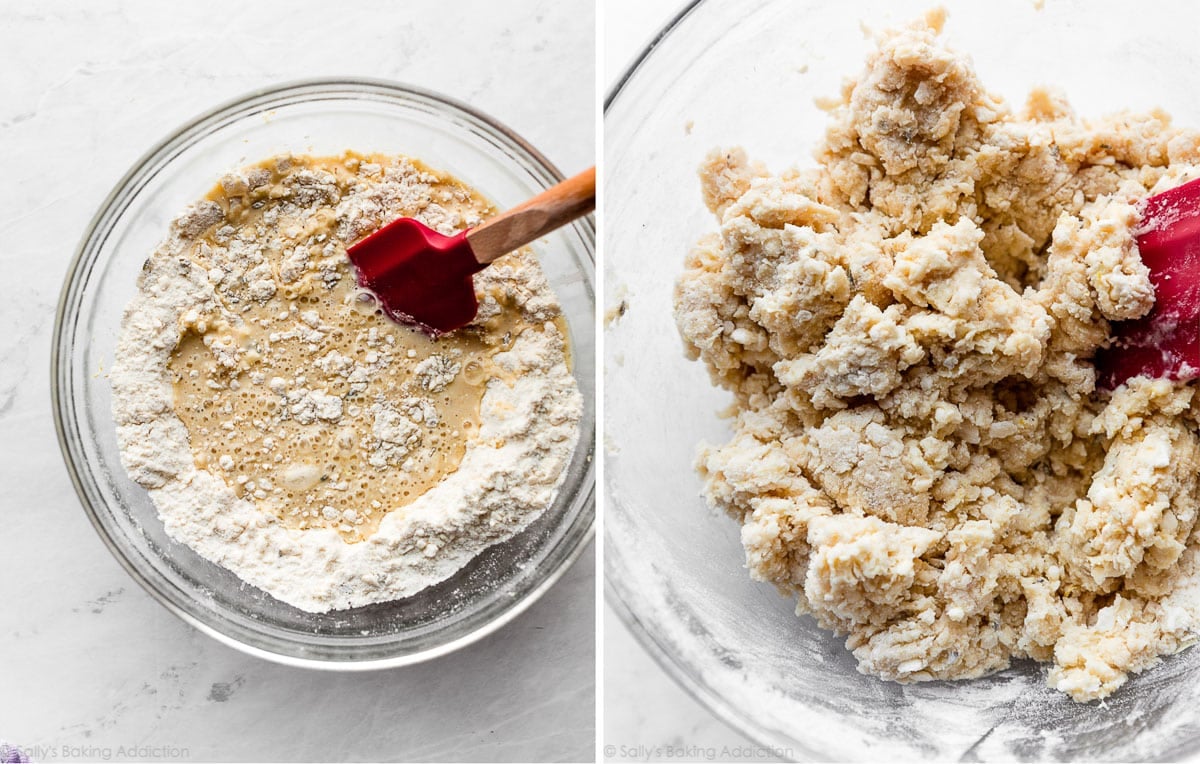
Best Lavender to Use for Lavender Scones
There’s a fine line between eating a deliciously flavored lavender treat and eating potpourri. And up until recently, I was totally new to cooking with lavender. You might be too, so let me help you determine the best lavender to use here. This multi-use dried culinary lavender is perfectly edible and a wonderful addition to food, drinks, essential oils, and more. It’s exactly what I use when I make lavender scones.
Baker’s Tip: When transferring the sticky shaped scones from your work surface to the lined baking sheet, use a thin spatula. This is where the scones can fall apart, but a thin spatula helps seamlessly transfer the dough around.
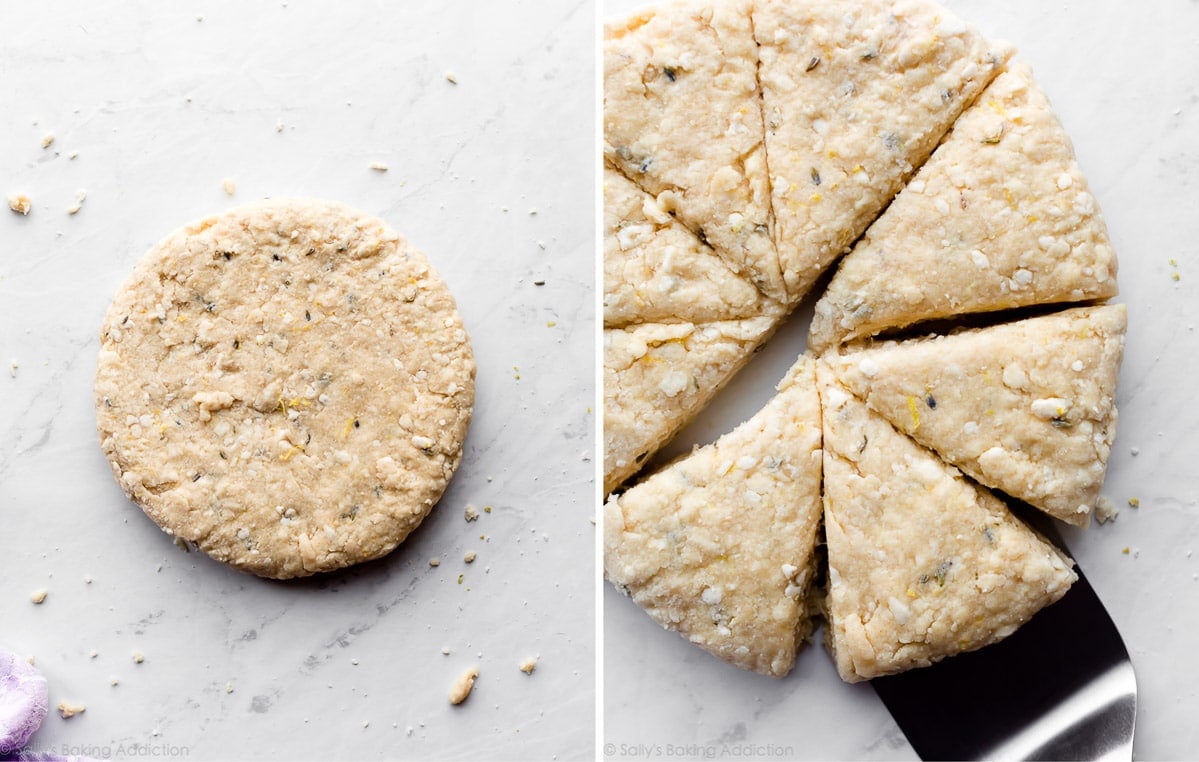
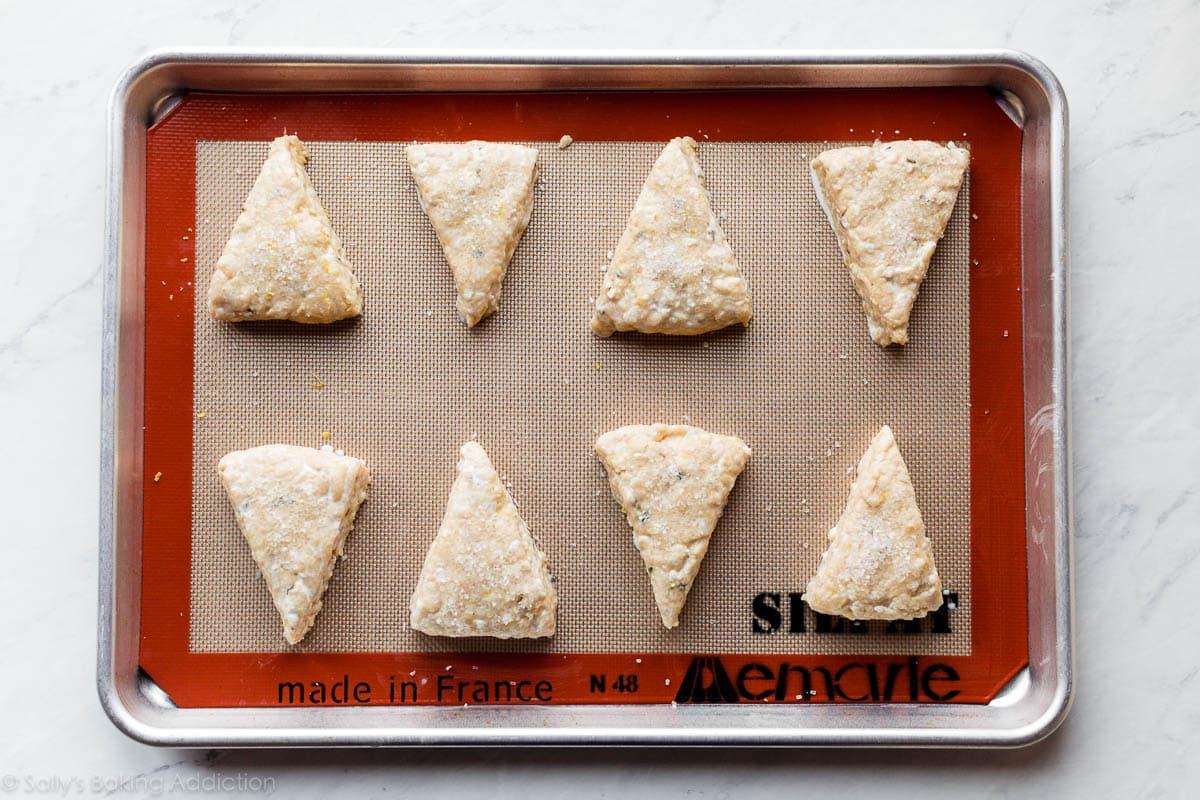

Lavender Scones Icing
Since the lavender flavor is so light in the scones themselves, using lavender again in the icing makes sense. The best way to make lavender icing is to infuse the liquid ingredient (milk) with plenty of lavender flavor. Bring milk to a simmer, then let it steep with 1 teaspoon of dried cooking lavender. Strain the lavender through a fine mesh strainer, then whisk the infused milk with a little lemon juice and confectioners’ sugar. The icing is way easier than it sounds!
If you don’t have a fine mesh strainer (affiliate link to my favorite set), pick one up. You’ll use it a lot in your baking, especially when a recipe calls for a sifted ingredient.
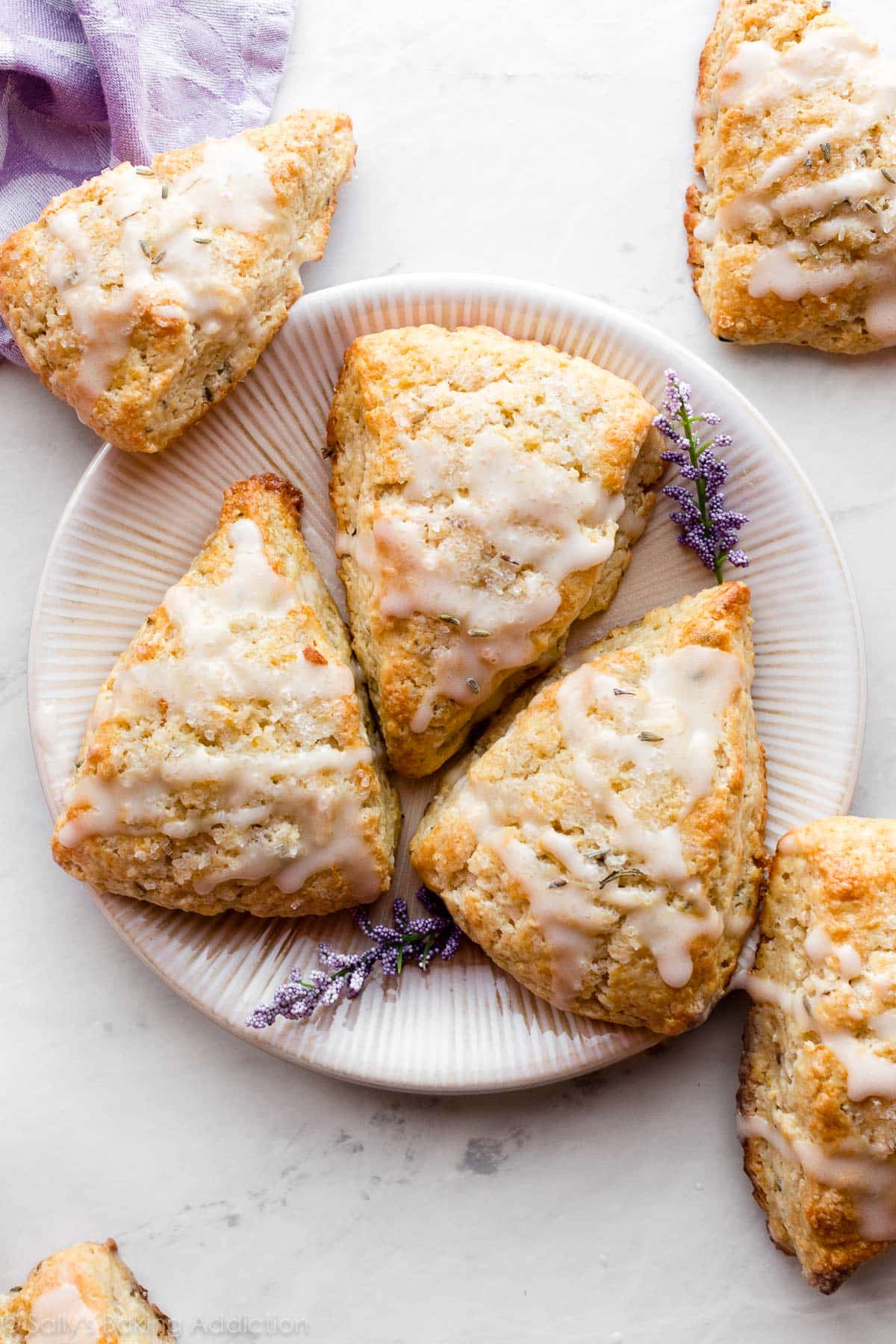
I know you’ll love these!
Print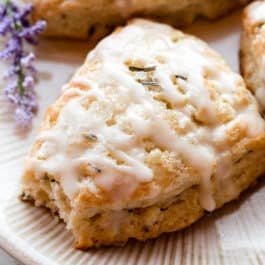
Lavender Buttermilk Scones
- Prep Time: 45 minutes
- Cook Time: 25 minutes
- Total Time: 1 hours, 15 minutes
- Yield: 8 large or 16 small scones
- Category: Breakfast
- Method: Baking
- Cuisine: American
Description
Using my favorite scones recipe, you can make bakery-style lavender scones right at home. They’re buttery and moist with crisp crumbly edges and soft flaky centers. Read through the recipe before beginning. You can skip the chilling for 15 minutes prior to baking, but I highly recommend it to prevent the scones from over-spreading.
Ingredients
- 2 cups (250g) all-purpose flour (spooned & leveled), plus more for hands and work surface
- 1/2 cup (100g) granulated sugar
- 2 and 1/2 teaspoons baking powder
- 2 teaspoons dried culinary lavender
- 2 teaspoons lemon zest
- 1/2 teaspoon salt
- 1/2 cup (8 Tbsp; 113g) unsalted butter, frozen
- 1/2 cup (120ml) buttermilk, plus 2 Tablespoons (30ml) for brushing
- 1 large egg
- 1 and 1/2 teaspoons pure vanilla extract
- optional: coarse sugar for topping
Lemon Lavender Icing
- 3 Tablespoons (45ml) heavy cream or milk
- 1 teaspoon dried culinary lavender
- 1 Tablespoon (15ml) fresh lemon juice
- 1 and 1/4 cups (150g) confectioners’ sugar
Instructions
- Whisk flour, sugar, baking powder, lavender, lemon zest, and salt together in a large bowl. Grate the frozen butter using a box grater. Add it to the flour mixture and combine with a pastry cutter, two forks, or your fingers until the mixture comes together in pea-sized crumbs. See video and photo above for a closer look at the texture. Place in the refrigerator or freezer as you mix the wet ingredients together.
- Whisk 1/2 cup buttermilk, the egg, and vanilla extract together in a small bowl. Drizzle over the flour mixture, then mix together until everything appears moistened.
- To make triangle scones: Pour onto the counter and, with floured hands, work dough into a ball as best you can. Dough will be sticky. If it’s too sticky, add a little more flour. If it seems too dry, add 1 more Tablespoon buttermilk. Press into an 8-inch disc and, with a sharp knife or bench scraper, cut into 8 wedges. For smaller scones, press dough into two 5-inch discs and cut each into 8 wedges. To make 10-12 drop scones: Keep mixing dough in the bowl until it comes together. Drop scones, about 1/4 cup of dough each, 3 inches apart on a lined baking sheet.
- Brush scones with remaining buttermilk and for extra crunch, sprinkle with coarse sugar. (You can do this before or after refrigerating in the next step.)
- Place scones on a plate or lined baking sheet (if your fridge has space!) and refrigerate for at least 15 minutes.
- Meanwhile, preheat oven to 400°F (204°C).
- Line a large baking sheet with parchment paper or silicone baking mat(s). If making mini or drop scones, use 2 baking sheets. After refrigerating, arrange scones 2-3 inches apart on the prepared baking sheet(s).
- Bake for 18-26 minutes or until golden brown around the edges and lightly browned on top. Larger scones take closer to 25 minutes. (Tip: I like to start the icing while the scones cook so the milk has a chance to steep.) Remove from the oven and cool for a few minutes before icing.
- Make the icing: In a small saucepan over low heat, bring the milk to a simmer. Remove from heat and immediately add the lavender. Set aside to steep for 15 minutes. Strain the milk through a fine-mesh sieve set over a bowl, then discard the lavender. Cool for 5 minutes. Whisk in the lemon juice and confectioners’ sugar. Feel free to add more confectioners’ sugar to thicken, if desired. Drizzle over warm scones. Icing can be made 1-2 days ahead and stored in the refrigerator.
- Leftover scones keep well at room temperature for 2 days or in the refrigerator for 5 days.
Notes
- Freeze Before Baking: Freeze scone dough wedges on a plate or baking sheet for 1 hour. Once relatively frozen, you can layer them in a freezer-friendly bag or container. Bake from frozen, adding a few minutes to the bake time. Or thaw overnight, then bake as directed.
- Freeze After Baking: Freeze the baked and cooled scones before topping with icing. I usually freeze in a freezer-friendly bag or container. To thaw, leave out on the counter for a few hours or overnight in the refrigerator. Warm in the microwave for 30 seconds or on a baking sheet in a 300°F (149°C) oven for 10 minutes.
- Overnight Instructions: Prepare scones through step 4. Cover and refrigerate shaped scones overnight. Continue with the recipe the following day.
- Special Tools (affiliate links): Glass Mixing Bowls | Box Grater | Pastry Cutter | Bench Scraper | Baking Sheet | Silicone Baking Mat or Parchment Paper | Pastry Brush | Citrus Zester | Citrus Juicer | Fine Mesh Sieve
- Over-spreading: Start with very cold scone dough. Expect some spread, but if the scones are over-spreading as they bake, remove from the oven and press back into its triangle shape (or whatever shape) using a rubber spatula.
- Lemon: 1 medium lemon is plenty for the zest and juice you need for this recipe (zest for the dough and juice for the icing).
- Buttermilk: You can substitute heavy cream for buttermilk if desired. Acidic buttermilk isn’t needed in order for the scones to rise since we’re using baking powder. However if you’d like the tangy flavor you can make your own buttermilk substitute. Add 1 teaspoon of fresh lemon juice or white vinegar to a liquid measuring cup. Add enough milk to make 1/2 cup. Whisk together, then let sit for 5 minutes before using in the recipe. For the extra 2 Tablespoons needed for brushing on top of the scones, you can use regular milk or heavy cream. Whole milk is best for the DIY sour milk substitute, though lower fat or nondairy milks work in a pinch. (The scones will spread more if using lower fat or nondairy milks.)


















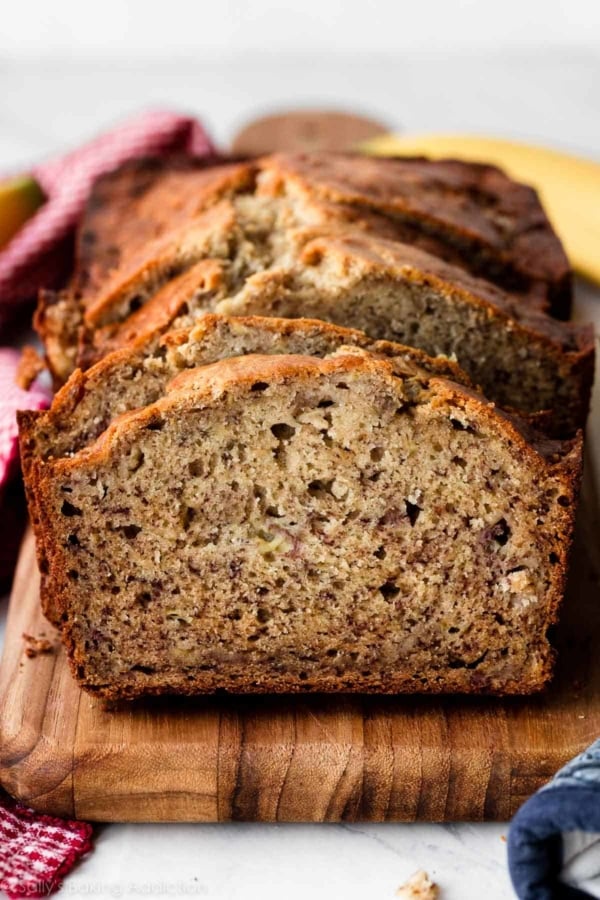

Reader Comments and Reviews
Thank you for sharing your recipe! It’s delicious, however, it’s a lot more fluffy than ones I’ve purchased from a bakery. How can I make them more dense? Did I do something wrong?
These are sooooo good! I used a little more lavender but realize this can be a taste preference. I am gluten free and used 1.5 cups ‘Cup4Cup’ and 1/2 cup Bob’s 1:1, and chilled these in freezer for 30 minutes (a necessary step for gf scones). These are a frequently requested scone from friends and family…
can i use lavender from my garden?
Hi Madison, We recommend culinary lavender instead of fresh to ensure it hasn’t been treated with chemicals. But if you know your own garden is chemical free you could certainly try drying yours. If you’re interested in drying your own – look up a quick tutorial for drying lavender at home– it’s easy!
This was amazing.
These scones are very delicious and have an amazing scent while baking. They were very good, but a little too lavender-y for my taste.
the scones are great! however mine did spread an awful lot bespite leaving them in the fridge for 20 minutes prior to baking. I think the hot, sticky weather we were having may have helped them turn more into tasty blobs over tasty triangles
I made these and they tasted amazing. Texture was spot on. HOWEVER, my only concern was the overspreading. I did freeze the shaped scones 45 minutes prior to baking but could it be that my dough was a bit too sticky from the beginning that caused the overspreading?? My other question is, would baking soda make a difference? I noticed its not used. I also mill my own flour which i know changes things but any insight on what I could’ve improved will help, please and thank you ! I plan to sell some this weekend and want to perfect them
Sally, I ADORE all of your scone recipes. All have been big hits at my house. Thank you! I have some lavender syrup. Any advice on using this with the recipe, or save it for the glaze?
Thank you!
Hi Katie, it may be best to save the syrup for the glaze, but let us know if you do give it a try in the scones!
These were incredible… My 3 year old daughter and I made them for a special tea party together and we enjoyed every bite!
Hey there! Could lavender extract paste be using instead of what is listed?
Hi Casey, We’ve never used lavender paste before but since it’s more concentrated, we recommend reducing the amount to 1 teaspoon. You can whisk it with the wet ingredients.
Could I add blueberries or blackberries to this recipe?
Yes, feel free to add between 1 and 1.5 cups of berries. Enjoy!
Hi Sally, The pictures look like you left the lavender in and didn’t strain it as I see some on the icing also. If those little pieces aren’t lavender what might they be?
Hi Kirsten, 2 tsp dried lavender goes into the dough (see step 1). We do strain the icing, but we added a little extra lavender to the scones as a garnish for the photos.
Hello Sally,
I can’t wait to try your scones. I have loved your other scone recipes. Can I use something else? Other than lavender another citrus perhaps? Thank you so much.
Hi Cally, for a version without lavender, you can simply omit the lavender or try one of our other flavor combinations instead. Enjoy!
Amazing! I loved these! Perfect amount of lavender for my tastes!
Great recipe. If I want to use heavy cream (35%), how much should I use to replace the buttermilk? Thank you.
Hi Nancy, you can use the same amount. Enjoy!
Love this recipe! The lemon peel and lavender buds play off each other excellently to prevent any soapy taste. I made about 12 mini scones and have the extra dough in my freezer so I can make them fresh any time.
Is the lemon zest needed or can it be replaced with something else?
Hi Michelle, the lemon zest and juice add flavor here, if you don’t have fresh you could add some lemon extract instead. We recommend anywhere between 1/2 – 1 teaspoon lemon extract. (It’s pretty potent!)
I was hesitant at first because the dough didn’t feel like it had the same consistency as another recipe I love, but I followed the recipe exactly. I’m so glad I did because this scone recipe is absolutely the BEST!!
We think this is a great recipe for scones, but why so much sugar in the icing? We used ¼ cup and found that sweet enough.